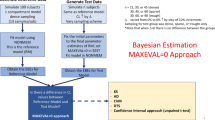Abstract
Purpose. To design a parsimonious population pharmacodynamic experiment that has the same or greater efficiency than that provided by two phase I studies.
Methods. The design was based on optimization of the population Fisher information matrix. Options for optimization were (1) determination of the optimal sampling times for each group (“group” represents a group of subjects that have identical design characteristics), (2) determination of the optimal doses for each group, and (3) determination of the optimal group structure.
Results. (1) Optimizing the sampling times, while retaining only four unique times per group, provided a more parsimonious experiment with the same efficiency as the original “study” that involved on average 10 samples per subject. Splitting sampling times between the first dose and a steady-state dose gave the most informative design. (2) The optimal dose was the same in all groups and was the upper bound of the dose range. (3) The optimal population design consisted of only one group with four unique sampling times that are the same for all subjects.
Conclusion. A population pharmacodynamic trial design is presented that is more parsimonious than the original study and would be appropriate for inclusion in a premarketing clinical study.
Similar content being viewed by others
REFERENCES
I. Ragueneau, C. Laveille, R. Jochemsen, G. Resplandy, C. Funck-Bretano, and P. Jaillon. Pharmacokinetic-pharmacodynamic modeling of the effects of ivabradine, a direct sinus node inhibitor, on heart rate in healthy volunteers. Clin. Pharmacol. Ther. 64:192-203 (1998).
S. Duffull, S. Chabaud, P. Nony, C. Laveille, P. Girard, and L. Aarons. A pharmacokinetic simulation model for ivabradine. Eur. J. Pharm. Sci. 10:285-294 (2000).
S. B. Duffull and L. Aarons. Development of a sequential linked pharmacokinetic and pharmacodynamic simulation model for ivabradine in healthy volunteers. Eur. J. Pharm. Sci. 10:275-284 (2000).
F. Mentré, A. Mallet, and D. Baccar. Optimal design in random-effects regression models. Biometrika 84:429-442 (1997).
M. Tod, F. Mentré, Y. Merlé, and A. Mallet. Robust optimal design for the estimation of hyperparameters in population pharmacokinetics. J. Pharmacokinet. Biopharm. 26:689-716 (1998).
B. Jones, J. Wang, P. Jarvis, and W. Byrom. Design of cross-over trials for pharmacokinetic studies. J. Stat. Plan. Inference 78:307-316 (1999).
V. V. Fedorov. Theory of Optimal Experiments, Academic Press, London, 1972.
É. Walter and L. Pronzato. Identification of Parametric Models from Experimental Data, Springer, Paris, 1997.
V. F. Cosson and E. L. Fuseau. Mixed effect modeling of sumatriptan pharmacokinetics during drug development: II. From healthy subjects to phase 2 dose ranging in patients. J. Pharmacokinet. Biopharm. 27:149-171 (1999).
E. M. Landaw. Optimal multicompartmental sampling designs for parameter estimation: practical aspects of the identification problem. Math. Comput. Sim. 14:525-530 (1982).
D. Z. D'Argenio. Optimal sampling times for pharmacokinetic experiments. J. Pharmacokinet. Biopharm. 9:739-756 (1981).
D. Z. D'Argenio. Incorporating prior parameter uncertainty in the design of sampling schedules for pharmacokinetic parameter estimation experiments. Math. Biosci. 99:105-118 (1990).
S. Retout, S. B. Duffull, and F. Mentré. Development and implementation of the population Fisher information matrix for evaluation of population pharmacokinetic designs. Comp. Meth. Prog. Biomed. (2000), in press.
M. Tod and J. M. Rocchisani. Implementation of OSPOP, an algorithm for the estimation of optimal sampling times in pharmacokinetics by the ED, EID and API criteria. Comp. Meth. Prog. Biomed. 50:13-22 (1996).
Y. Hashimoto and L. B. Sheiner. Designs for population pharmacodynamics: Value of pharmacokinetic data and population analysis. J. Pharmacokinet. Biopharm. 19:333-353 (1991).
L. Endrenyi. Design of experiments for estimating enzyme and pharmacokinetic parameters. In L. Endrenyi (ed.), Kinetic Data Analysis. Design and Analysis of Enzyme and Pharmacokinetic Experiments, Plenum, New York, 1981, pp. 137-167.
E. I. Ette, A. W. Kelman, A. C. Howie, and B. Whiting. Interpretation of simulation studies for efficient estimation of population pharmacokinetic parameters. Ann. Pharmacother. 27:1034-1039 (1993).
Vrijens B. and Goetghebeur E. Irregular drug intake reduces bias and improves precision in PK/PD population studies. University of Ghent, Center for Statistics, Technical Report 2000/1 (2000).
Author information
Authors and Affiliations
Rights and permissions
About this article
Cite this article
Duffull, S.B., Mentré, F. & Aarons, L. Optimal Design of a Population Pharmacodynamic Experiment for Ivabradine. Pharm Res 18, 83–89 (2001). https://doi.org/10.1023/A:1011035028755
Issue Date:
DOI: https://doi.org/10.1023/A:1011035028755




